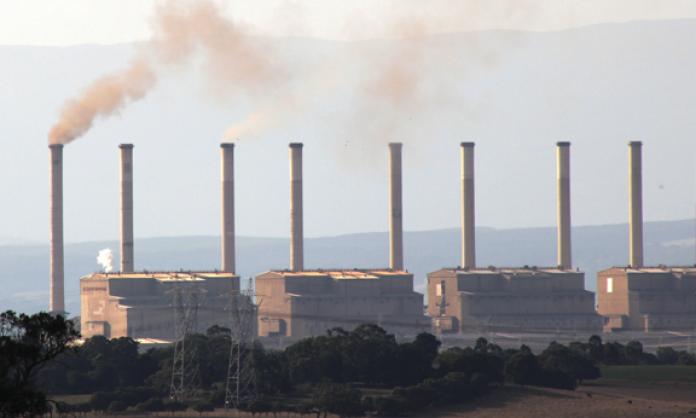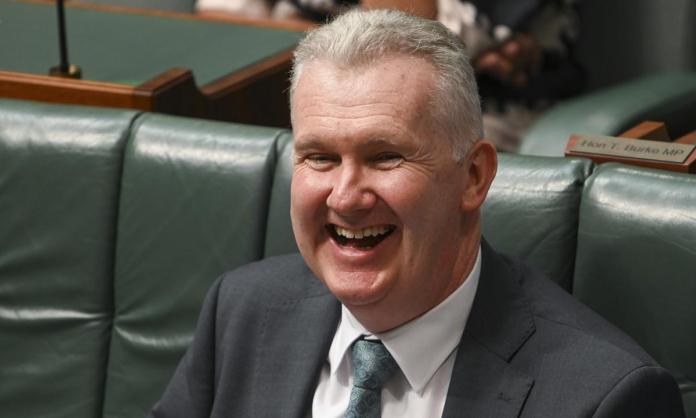The last puff of smoke rose above Hazelwood power station’s grey stacks on 29 March; at 4.56pm the turbines were turned off for the last time. In the car park, workers assembled, talked and exchanged contact details; many, symbolically, attached their hard hats to the cyclone fence.
“I feel gutted for the younger blokes”, John, who worked at Hazelwood and the adjacent Morwell site for 50 years, later told me. “They went to Hazelwood with the belief that it would be operational until 2025 … There was an expectation there would be a staged shutdown, but [after management’s announcement] … the disbelief turned to anger with how they went about it over only five months. Their attitude didn’t alter over that time. It’s such a sad, sad day.”
I had been visiting in Morwell, my childhood home in Victoria’s Latrobe Valley, gauging reactions to the plant’s imminent closure. Ann, a local store owner, expressed anger at the “officials” from Melbourne who managed the shutdown, and at those union leaders who made only short visits to the area and then returned to the security of homes and jobs in the city. She feels betrayed by the politicians, who, she believes, have not done enough to protect the livelihoods of people in the region.
Over the last decade and especially since the announcement of Hazelwood’s closure, political perspectives have generally been positioned between concern for the impact on the valley communities and celebration at the demise of Australia’s “dirtiest” power station. But the story of Hazelwood is more complex. Taking a longer view, the closure can be situated in the social and economic changes of Australian and international capitalism.
STATE BUILDING
In 1908, Thomas Tait, chair of the commissioners of Victorian Railways, employed Charles Merz, a consulting engineer from Great Britain, to explore a proposal to electrify Melbourne’s train system. Merz was an expert in regional-scale power systems, with experience in the north of England and several other locations. His work involved planning and costing power transmission and distribution. In 1919, he was again commissioned to comment on an electricity generation proposal for Melbourne – the Morwell Power Scheme. Merz viewed power not simply as a utility, but through the broader lens of economic development. His report to the Victorian parliament noted:
“[T]his whole question of electric power should be looked at from the point of view of the State as a whole … I would urge the importance of a cheap supply of power, not only for Melbourne, but throughout the state for agricultural as well as for manufacturing purposes.”
Legislation was passed to establish an electricity commission, which became the State Electricity Commission of Victoria (SECV). The commission had wide-ranging powers to consolidate, coordinate and regulate power production. In June 1920, John Monash was appointed general manager. Under his direction, a state electricity system was established and the coalfields of the Latrobe Valley opened up.
For the next 60 years, Merz and Monash’s vision of a unified and coordinated power system was brought to life. The SECV played a pivotal role, coordinating the takeover of land, control of waterways, roads and highways, and the establishment, control and dismantling of the town of Yallourn.
In 1959, the state government resolved to create the Hazelwood Power Station, which would be built in sections and timed to come on line between 1964 and 1970.
I was 10 years old at the time of the announcement. In due course, the new development became Morwell’s dominant feature as the units, with their large smokestacks, appeared on a ridge three to four kilometres south of the town. The complex of four large buildings, with their eight chimneys, became fixed on the landscape.
This first period of Hazelwood was marked by celebration, optimism and confidence about the importance of the region as a power supplier for Victoria and the Latrobe Valley’s long term future. Hazelwood increased electricity output during a time of manufacturing expansion in Victoria. The plant also fostered local economic growth through the size of its workforce and the associated stimulus to the overall economy of the region.
While the plant is now recognised as something of a dinosaur, originally it was state of the art, using new technologies designed to combat problems with the moisture and composition of the coal, which had created serious difficulties in the adjacent Morwell Power Plant.
‘DUST IN THE AIR’
For all the optimism, economic development came at a price for locals. In 2001, ABC Television’s Four Corners aired “Power without glory”, an account of “the men who lived and worked routinely with asbestos in Victoria’s Latrobe Valley power industry”. It documented the stories of people who were suffering from asbestos-induced diseases.
Subsequent studies have highlighted the seriousness and extent of the problem and the ways in which political imperatives and management practices combined to downplay such issues. As Cecily Hunter and Anthony LaMontagne wrote in a piece published by the Victorian Trades Hall Council site ohsrep.org.au, “The exposure of SEC employees to asbestos and other dusts could be accounted for in terms of the priority given to maintaining productive processes over workers’ health, in an enterprise vital to the state’s economy”.
They named their 2012 study “Dust in the air”, which highlighted that industrial illness and disease were not confined to those working at the power stations. Everyone living in the adjacent areas was subject to the effects of the pollutants in the atmosphere.
This issue was again brought to light by the health problems experienced by people living in Morwell during the coal fire in the Hazelwood mine in 2014. Toxic fumes covered the town for the 45 days it took to extinguish the blaze. The fire was just one in a chronology of issues associated with the mine site, including previous fires in the pit, large landslips, problems managing water flows in the coalfield and, tragically, an explosion that killed three workers in 1978.
EXTRACTIVE CAPITALISM
In 1993, the Victorian Liberal government announced plans to restructure the SECV, beginning a process of corporatising the state’s power industry. Three separate businesses were created: power generation, power transmission and distribution and retail. In 1996, privatisation began. Hazelwood Power Corporation was sold to British National Power.
In 2003, the power station underwent another identity change when British Power was separated into two divisions, one for the UK and a second for international operations. This second group, controlling Hazelwood, became International Power and, after yet another market transaction, was taken over by the French company GDF Suez, which is now rebranded as Engie.
The changes came during a powerful political and industrial push for “economic reform”. This development was fuelled by the rise of neoliberalism, with its agenda to economise and maximise the reach of capital. But the promises made to the broader population – lower costs, greater efficiencies, greater choice – never materialised. “Efficiency” was code only for maximising private profit: cutting corners and letting the infrastructure degrade.
More than that, it meant the loss of invaluable local expertise and work practices in managing a volatile and combustible coal mine. Brian, who worked in the valley power industry for more than 40 years, including 28 in senior management, told me that the problems starkly exposed in the 2014 mine fire could be traced back to the decision to privatise what had previously been a state-managed enterprise.
For Hazelwood, the result of the “efficiency” drive was the abandonment of standard safety practices and having owners and controllers in France who were uninterested in, or blind to, the very real problems building up at the plant. We still don’t know the full health ramifications of the fire. A September 2014 analysis by health statistician Adrian Barnett concluded that there were at least 11 “excess deaths” during February and March of that year, when the fire was burning. The spike in deaths continued, but there has been no serious attempt to gauge the long term effects of exposure to the toxic smoke and ash.
The rise and fall of Hazelwood and the local community are an example of “extractive capitalism”, whereby global corporations, in concert with national leaders of politics and industry, absorb, devour, destroy and abandon institutions, communities, local populations and natural environments.
At the end of March, within the local chorus of laments, anger and frustration, were Wayne’s words. As a part owner of a boutique furniture-making business, he said that it had been obvious for some time that Morwell’s economy was “broken” and “would not be returned to what it once was”. This did not greatly concern him or his partners. Having seen the emerging crisis, they had built a customer base in other parts of the region and in Melbourne – perhaps among the “officials” whom Ann decried.
Wayne’s position is emblematic of the spirit of neoliberal entrepreneurs – those who seek out new possibilities and opportunities in the ruins and rubble that the system creates. But for all the talk, how many people are in a position to take advantage of economic decline?
The absence of state planning means that there is now another cloud hanging over the Latrobe Valley – that of economic uncertainty and social decline. In Morwell, the number of house for sale signs is notable, as are the vacant shops. There is an emerging drug addiction problem. It’s no surprise that One Nation’s vote was higher than the Victorian average at the last federal election.
Hazelwood’s earlier history attests that state ownership and control are no guarantee of the welfare of the local workforce and population. But the market has meant even greater abandonment. The sense of that in the Latrobe Valley is palpable.








